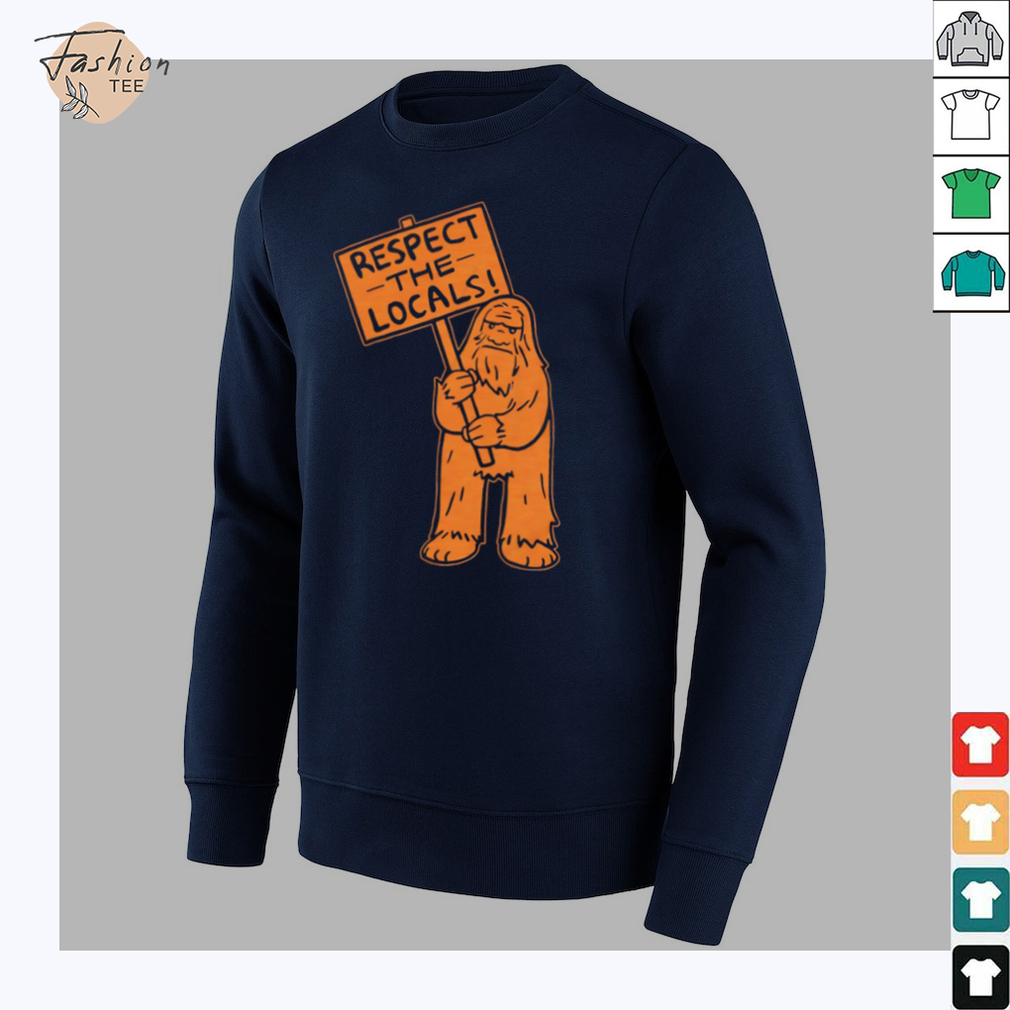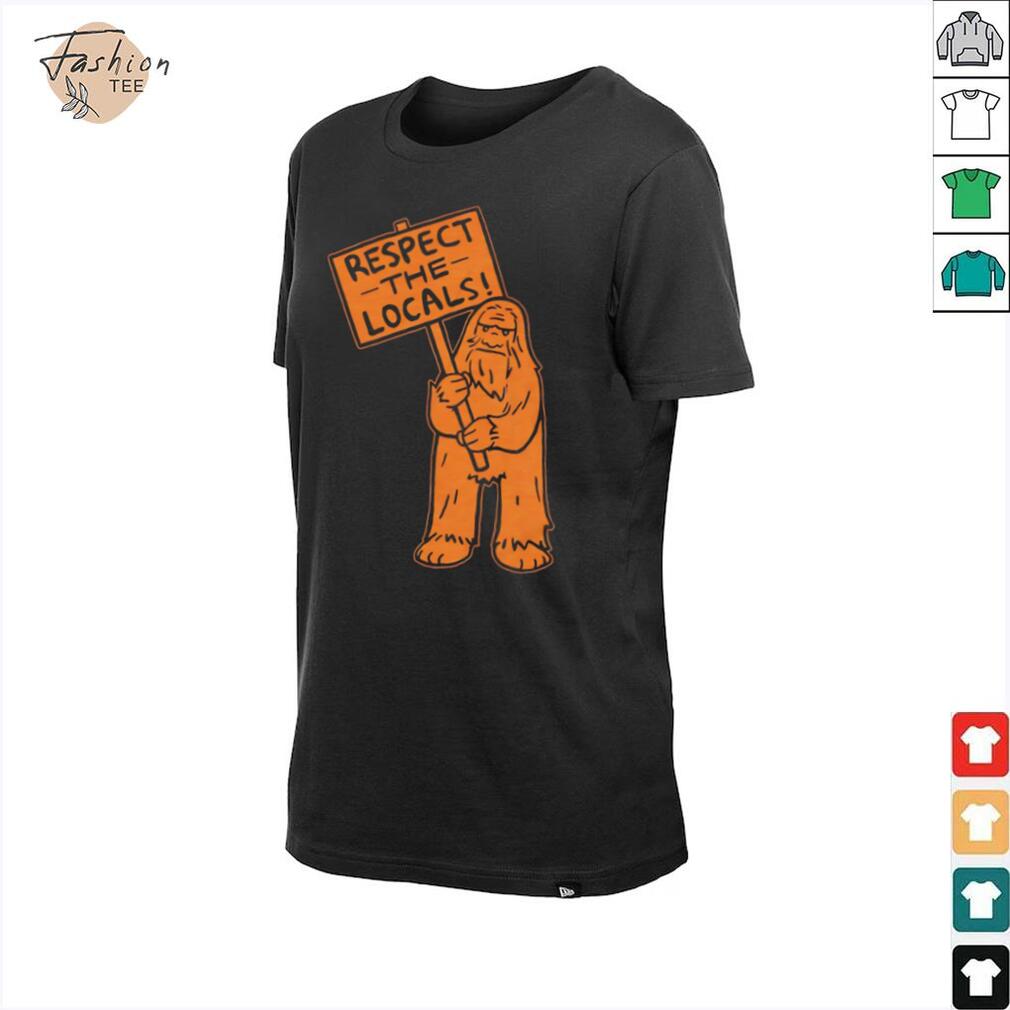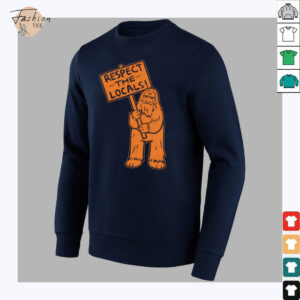Sasquatch Says: “Respect the Locals” – A Call for Wilderness Etiquette
The “Sasquatch respect the locals shirt” is a playful yet profound statement, advocating for mindful interaction with both the natural world and its inhabitants – real or legendary. This **shirt** isn’t just about the mythical creature **Sasquatch**; it’s a clever reminder to practice responsible outdoor etiquette and truly “**respect the locals**,” whether they be wildlife, indigenous communities, or even the elusive Bigfoot himself. The legend of **Sasquatch**, also known as Bigfoot, is deeply embedded in the folklore of the **Pacific Northwest** and various Indigenous cultures across North America, often described as a large, hairy, bipedal hominid residing in remote forests (Source: The Canadian Encyclopedia, Oregon Encyclopedia). For many Native American tribes, Sasquatch is not a monster but a spiritual figure, a guardian of nature, and a symbol of humanity’s deep connection to the wilderness (Source: Southern Style Sweet Tees blog). The Coast Salish peoples, for whom the term “Sasquatch” (from “Sasq’ets” meaning “wild man”) originated, view him as a protector of the forests, a being that exists in harmony with nature and may appear as an omen if humans exploit the land (Source: Southern Style Sweet Tees blog). My personal commentary: the idea that Bigfoot is watching us, not just hiding, adds a fascinating layer to wilderness ethics. But what are the historical roots of the “**Sasquatch**” legend among Indigenous peoples, how does the concept of “**respect the locals**” translate to outdoor adventures, and what impact can this **shirt** have on fostering responsible environmental stewardship?
The Ancient Roots of Sasquatch: Indigenous Lore and Guardianship
The legend of **Sasquatch** predates European settlement in North America, with numerous Indigenous cultures sharing tales of large, hairy, humanoid beings inhabiting their traditional lands. These stories are far richer and more complex than the modern “Bigfoot” caricature, often portraying Sasquatch as a spiritual figure, a guardian, or even a teacher. The Salish peoples of British Columbia coined the term “Sasq’ets,” meaning “wild man” or “hairy man,” and consider them guardians of the forest with the ability to move between physical and spiritual realms (Source: The Canadian Encyclopedia, SBS NITV). The Lakota Sioux speak of “Chiye-Tanka,” a great elder brother who watches over the land, while the Cherokee have legends of “Tsul ‘Kalu,” the Lord of the Game who oversees forest animals (Source: Southern Style Sweet Tees blog). These narratives emphasize a deep connection to nature and the consequences of disrespecting the environment. Unlike Western depictions, these beings are often seen not as something to be feared or hunted, but to be revered and understood as integral parts of the ecosystem (Source: Southern Style Sweet Tees blog). This profound cultural context is what gives the “**Sasquatch respect the locals shirt**” its true depth, urging us to consider the ancient wisdom that wilderness areas have always been home to others, visible or not. For another unique cultural statement, consider the Archers So Say Goodbye To Everything That We’ve Been shirt, which evokes a different form of existential reflection.
“Respect the Locals”: Etiquette for the Wilderness Explorer
The message “**respect the locals**” on this **shirt** is a crucial reminder for anyone venturing into the wilderness, whether they’re hiking, camping, or simply exploring. This principle extends beyond human communities to encompass wildlife, plant life, and the very ecosystems we visit. It means adhering to Leave No Trace principles: packing out what you pack in, staying on marked trails, and minimizing your impact on fragile environments (Source: Leave No Trace Center for Outdoor Ethics). It also involves respecting the privacy and traditions of any indigenous or local communities whose ancestral lands you might be traversing. For example, asking permission before taking photos, learning basic local greetings, and supporting local businesses are all ways to show respect (Source: FasterCapital, The Travel Tinker). When it comes to wildlife, “respect the locals” means observing from a distance, never feeding animals, and understanding that you are a guest in their home. The spirit of the **Sasquatch** legend, as a guardian of the forest, perfectly aligns with this ethos, serving as a symbolic reminder that the wild is not just a playground, but a living, breathing environment with its own rules and inhabitants. My commentary: it’s amazing how a simple phrase can encapsulate so much critical outdoor wisdom. This **shirt** promotes not just an idea, but a lifestyle of conscious exploration.
Sasquatch Sightings and Conservation: Protecting the Unseen
While the existence of **Sasquatch** remains a scientific mystery, the widespread belief in Bigfoot, particularly in the **Pacific Northwest** with over 700 reported sightings in Washington state alone (Source: The Spokesman-Review), has inadvertently contributed to a growing conversation about wilderness conservation. The idea that a large, undiscovered hominid might require vast, undisturbed habitats highlights the urgent need to protect old-growth forests and remote wilderness areas (Source: Oregon Wild, Hangar 1 Publishing). Various “Sasquatch preservation” efforts, including local ordinances in places like Skamania County, Washington, which has a Bigfoot protection law, emphasize the importance of safeguarding these natural spaces for all species, known and unknown (Source: ScholarWorks at UMass Boston). Whether Bigfoot is real or not, the lore itself serves as a powerful metaphor for the wild, reminding us that there are still mysteries to uncover and fragile ecosystems that desperately need our protection. This connection between cryptid lore and genuine environmentalism is a unique and viral trigger, encouraging people to care about preserving wild spaces. The “**Sasquatch respect the locals shirt**” subtly taps into this movement, making a statement that goes beyond belief in a cryptid; it’s a call to action for protecting the last remaining wild frontiers. Here’s the part they didn’t tell you: many serious conservationists quietly acknowledge that protecting potential Sasquatch habitats benefits countless other species too.
Embrace the Mystery: Get Your “Sasquatch Respect the Locals” Shirt
The “Sasquatch respect the locals shirt” is the perfect way to express your love for wilderness, your respect for all living beings, and your appreciation for the enduring mystery of **Sasquatch**. This **shirt** is more than just fun; it carries an important message about conscious exploration and valuing the natural world and its unseen inhabitants. Whether you’re a cryptozoology enthusiast, an avid hiker, or simply someone who believes in treating every environment with care, this **shirt** is a unique statement piece. Wear it proudly and join the silent movement to “**respect the locals**” – from the smallest squirrel to the legendary Bigfoot. For a closer look at this fascinating and thought-provoking apparel, revisit the Sasquatch respect the locals shirt!
—
Follow-up Questions:
H3: Beyond the T-Shirt: Deepening Our Connection to the Wild
- How can the “Respect the Locals” ethos be more broadly integrated into outdoor recreation guidelines to promote better ecological stewardship and cultural sensitivity?
- What are the most compelling scientific arguments for and against the existence of **Sasquatch**, and how do these arguments intersect with the cultural significance of the creature in Indigenous traditions?
- If **Sasquatch** were scientifically proven to exist, what immediate conservation challenges and ethical considerations would arise for its protection and interaction with humans?
- Beyond the specific legend of **Sasquatch**, what other cryptids or mythical creatures in global folklore serve as metaphors for environmental protection or local respect?
- How can engaging with folklore and local legends, like that of **Sasquatch**, foster a deeper sense of wonder and responsibility towards wilderness areas for a new generation of explorers?


















